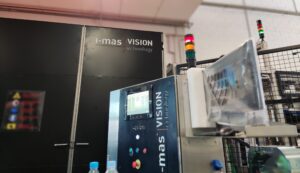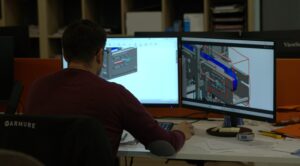Hyperspectral machine vision is revolutionizing quality inspection methods in multiple industries, offering capabilities far beyond what is visible to the human eye. This advanced technology captures detailed information in hundreds of spectral bands, making it possible to detect hidden characteristics such as chemical composition, food freshness or non-visible defects in industrial products.
In this article, we will explore how hyperspectral vision is opening new horizons in quality inspection, improving accuracy, efficiency and safety in sectors such as agriculture, manufacturing and medicine.
What is hyperspectral vision?
Hyperspectral imaging is an advanced imaging technology that allows materials to be identified and characterized non-invasively, providing information far beyond what is visible to the human eye. Each material has a unique composition that reacts in a particular way to the electromagnetic spectrum, and this reaction is captured as a “signature” or fingerprint by hyperspectral cameras (HEI).
Unlike traditional vision, each pixel of a hyperspectral image contains detailed information that makes it possible to identify and define the composition of different materials, from organic samples to metals. This creates a “hypercube,” a three-dimensional representation where two dimensions correspond to the morphology of the object, while the third reflects its chemical composition. This precise mapping not only identifies the components of a product, but also shows how they are distributed, thus ensuring their homogeneity.
Thanks to the combination of machine vision and infrared spectroscopy, hyperspectral vision has become an indispensable tool in quality inspection, especially in the food industry, where it monitors the composition and quality of products in real time, ensuring compliance with strict safety standards.
Advantages of hyperspectral imaging technology
Hyperspectral imaging (IHE) technology offers multiple advantages over conventional techniques, being a very powerful tool in industrial quality inspection:
- Non-destructive and non-invasive analysis: Allows inspection of materials without altering their structure, making it an ideal choice for sectors such as the food industry, where product integrity is key.
- No need for sample preparation: Unlike other techniques, hyperspectral imaging does not require materials to be processed or handled prior to inspection, which saves time and effort.
- No need for sample preparation: Unlike other techniques, hyperspectral imaging does not require materials to be processed or handled prior to inspection, which saves time and effort.
- Advanced applications through Deep Learning: Integrated with deep learning algorithms, this technology can solve multiple challenges in the agri-food industry and other sectors, automating quality control processes.
- Easy implementation in existing production lines: IHE easily adapts to already installed systems, facilitating their integration into the production line without the need for major modifications.
- Identification of chemical components: It is capable of detecting and differentiating multiple chemical components present in a sample, allowing its composition to be analyzed with a high degree of accuracy.
In addition, this technology makes it possible to analyze several samples simultaneously, select areas of interest within a sample and examine the spectrum of a particular pixel, all quickly and easily once the system has been calibrated and validated.
Uses of hyperspectral vision in the food industry
Hyperspectral vision has found a prominent place in the food industry, where it is used to automate inspection and analysis tasks that are difficult to solve with conventional machine vision. It can detect foreign bodies such as plastics or shells in food, predict the ripeness and shelf life of fruits and vegetables, and detect invisible defects such as bruising or mold. It is also used to measure sugar, fat and moisture levels in bakery products, as well as to evaluate the chemical quality of meat and dairy products.
We can say, therefore, that this technology is key to guarantee food quality and safety in an accurate and efficient way.
Hyperspectral vision at i-mas
In the engineering department of i-mas we are specialized in the combination of artificial vision technologies, deep learning and industrial automation in production processes, which allows us to offer integral solutions adapted to the specific needs of each client.
Want to learn more about our services? Contact us or visit our projects section!



